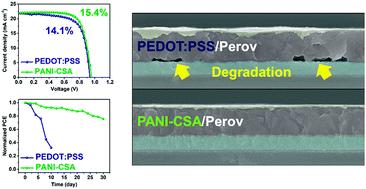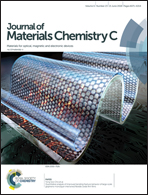Efficient and moisture-resistant hole transport layer for inverted perovskite solar cells using solution-processed polyaniline†
Abstract
Inverted-structure perovskite solar cells (PSCs), with low-temperature processed poly(3,4-ethylenedioxythiophene):poly(styrene-sulfonate) (PEDOT:PSS) and perovskite-passivating phenyl–C61–butyric acid methyl ester (PCBM) employed as charge transport layers, have great potential as efficient, flexible, and hysteresis-free solar cells. However, PEDOT:PSS processed from an aqueous solution has a hygroscopic nature, and can degrade the ambient stability of moisture-vulnerable perovskite electronics. Furthermore, excess insulating PSS in the PEDOT:PSS complex can deteriorate the hole extraction and photovoltaic performance of the solar cell. In this work, polyaniline doped with camphorsulfonic acid (PANI-CSA) is introduced as a hole transport layer (HTL) to promote hole extraction ability and improve the efficiency and stability of inverted PSCs. The device fabricated with PANI-CSA exhibited superior photovoltaic performance, with a maximum efficiency of 15.42%, compared to 14.11% efficiency for the device fabricated with PEDOT:PSS. Most notably, the stability of the device fabricated with PANI-CSA was greatly improved due to a stable HTL/perovskite interface against exposure to ambient moisture.



 Please wait while we load your content...
Please wait while we load your content...